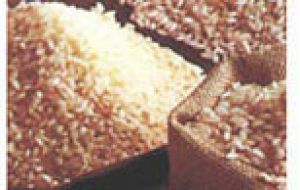MercoPress. South Atlantic News Agency
Swiss researchers uncover microscopic fungus which speeds rice growth
 Rice is the most produced and consumed world grain
Rice is the most produced and consumed world grain Researchers at a Swiss university said Thursday that they have uncovered a microscopic fungus that is able to increase the speed of rice growth by five times. In a study published by Switzerland's University of Lausanne, researchers claimed that the fungus mycorrhiza would not only cut the use of phosphate fertilizers, it was also “completely natural” or GM-free.
Tinkering with a type of fungus that lives in association with plant roots, researchers found a way to increase the growth of rice by an impressive margin. The so-called mycorrhizal fungi are found in association with nearly all plants in nature, where they deliver essential nutrients—specifically phosphate—to plants in return for sugar.
The findings are nevertheless a surprise, according to researchers reporting online on June 10th in Current Biology, because there has been little evidence thus far to suggest that crop plants actually respond to the fungi.
“Global reserves of phosphate are critically low, and because the demand for phosphate goes hand in hand with human population expansion, it is predicted that there will be major shortages in the next few decades,” said Ian Sanders of the University of Lausanne in Switzerland.
“Unfortunately, most of our important crop plants do not respond strongly, if at all, to inoculation with these fungi. This is especially so for rice, the most globally important food plant. There are no clear reports that rice benefits from inoculation with mycorrhizal fungi.”
That is, until now. In fact, the researchers started with a strain of mycorrhizal fungus of the species Glomus intraradices that clearly didn't benefit rice. They then took advantage of the fungus's unusual genetics. A single fungal filament can contain genetically distinct nuclei. Those distinct nuclei can fuse together, mixing genes up in different combinations, and fungal spores can also end up with different complements of genes, the new research shows. As such, the supposedly clonal fungi maintain a degree of genetic variation that had been overlooked.
“It turns out we can very simply manipulate their genetics to produce fungi that induce up to a five-fold growth increase in this globally important food plant,” Sanders said.
The genetic changes that the researchers produced in the fungi led to changes in the activity of important genes in the rice, they report. Those affected genes are known to be involved in establishing the mutually beneficial relationship between plant and fungus and in the transport of phosphate at the interface between fungus and plant.
Sanders emphasized that the genetic manipulation the researchers undertook didn't involve any insertion of new genes into the fungal genome. It rather relied on the same biological processes of genetic exchange and segregation that normally take place in the fungus. “What we have done with these fungi is not much different from what plant breeders, and farmers before them, have done to improve crops,” he said. “The only difference is that the genetics of these fungi is a little bit more unusual, and no one thought it worth doing.”
On a cautionary note, Sanders did emphasize that the plants they studied were grown in a greenhouse in Switzerland under conditions that only mimicked those found in the tropics. “This is clearly not at all the same environment as a rice plant growing in a real paddy field,” he said. It remains to be seen whether the same growth benefits will apply in practice.
“However,” Sanders said, “our study clearly shows that the potential is there to manipulate the genetics of the fungus to achieve greater crop yields.”
It could be commercialised and used in large-scale farming in two to five years, said the researchers. The team uncovered the function of the super fungus after four years of experiments on twenty different samples of its spores.




Top Comments
Disclaimer & comment rulesCommenting for this story is now closed.
If you have a Facebook account, become a fan and comment on our Facebook Page!